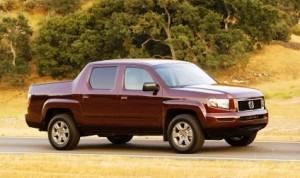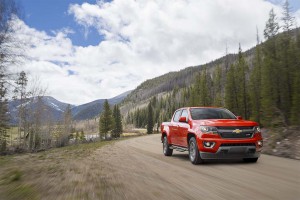Honda expects to get as much as five miles per gallon better mileage out of its reborn Ridgeline pickup when it goes on sale over the summer.
That’s in keeping with a general trend that’s seen a big boost of the fuel economy of next-generation trucks and SUVs. And, industry leaders are betting, it will mean that American motorists will be far less likely to flee back to conventional sedans and coupes if – or, more likely, when – fuel prices start rising again.
According to figures filed with the Environmental Protection Agency, which oversees mileage testing, the front-wheel-drive version of the 2017 Honda Ridgeline will deliver 19 mpg in the city, 26 on the highway. The all-wheel-drive model will trim a single mpg off those numbers, to 18 and 25.
By comparison, the old Ridgeline, which was abandoned after the 2014 model-year, got just 15 mpg around town and 21 on the highway.
(Automakers delivering better-than mandated mileage. Click Here for the story.)
To put the latest numbers into perspective, the latest version of the Chevrolet Colorado (and near-twin GMC Canyon) get up to 17 city, 24 highway with their gas engine packages. They picked up 3 mpg city, 5 highway compared to the old General Motors trucks when relaunched two years ago. Meanwhile, the latest version of the Toyota Tacoma comes in at 18 and 23.
Both the Toyota and GM trucks, however, are conventional, body-on-frame designs offering each rear- or four-wheel-drive. The all-new version of the Honda Ridgeline has retained its unibody construction and is expected to be a fair bit lighter than its competitors.
Honda hasn’t been saying much about the 2017 Ridgeline since the pickup made its debut at the North American International Auto Show last January. It did reveal the truck will be powered by a 3.5-liter V-6 making 280 horsepower and 262 pound-feet of torque.
Honda won’t have a diesel. That could prove the package of choice for those who want the absolute maximum fuel economy in a midsize pickup, with the EPA giving the Colorado and Canyon oil-burners a rating of 31 mpg in rear-drive configuration and 29 mpg in the rear-drive diesel package.
Nonetheless, the new Honda Ridgeline has little to apologize for at up to 26 mpg on the open road. These are the sort of numbers that even compact sedans would have struggled to deliver not all that many years ago, reflecting the significant effort the industry has made in driving up fuel economy.
Credit a variety of factors, including the lighter weight of the truck’s unibody design, improved aerodynamics and a number of anticipated improvements in the driveline – which pairs the V-6 with a six-speed automatic transmission.
Among the details likely to be released in the coming weeks, as journalists – including those from TheDetroitBureau.com – get to drive the new Ridgeline will be payload and towing capacity. Honda previously hinted that the 2017 model will have a cargo capacity of around 1,600 pounds.
(For the latest on the Mitsubishi fuel economy scandal, Click Here.)
The new Ridgeline is still considered a midsize, but Honda has rejiggered its dimensions where it counts. The bed is now five feet wide and 5’4” long – 5.4 inches wider and four inches longer than before. And the bed can handle a four-foot sheet of plywood lying flat.
The fully independent front and rear suspension should provide a more car-like ride and Honda claims the unibody platform also permits a variety of novel features, some carried over from the old Honda Ridgeline, others new. There’s a hidden “trunk” beneath the composite, scratch-resistant bed, for example. And to access cargo, Honda uses a dual-action tailgate that can either swing down, like a conventional truck, or to the side.
The bed also features eight 350-pound tie-down cleats, as well as a 400-watt power inverter. That’s enough to run a blender for a tailgate party, the maker notes, or even a widescreen TV. There’s even an optional bed-mounted audio system with six “exciters,” rather than conventional speakers, pumping out 540 watts of sound.
(Want to burn lots more gas? Add a roof rack. Click Here for the story.)



